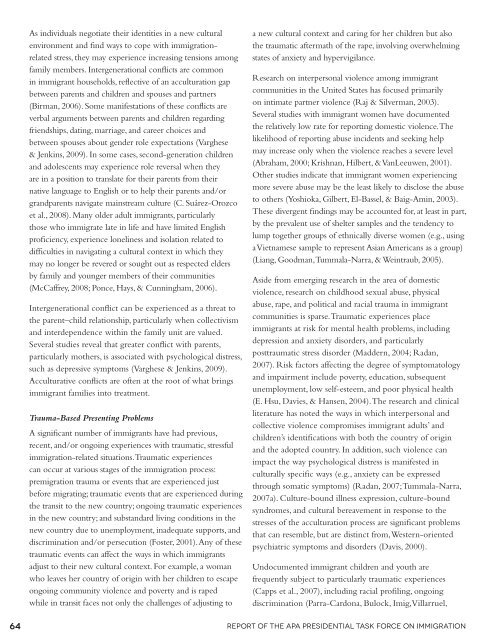Crossroads: The Psychology of Immigration in the New Century
Crossroads: The Psychology of Immigration in the New Century
Crossroads: The Psychology of Immigration in the New Century
Create successful ePaper yourself
Turn your PDF publications into a flip-book with our unique Google optimized e-Paper software.
As <strong>in</strong>dividuals negotiate <strong>the</strong>ir identities <strong>in</strong> a new cultural<br />
environment and f<strong>in</strong>d ways to cope with immigrationrelated<br />
stress, <strong>the</strong>y may experience <strong>in</strong>creas<strong>in</strong>g tensions among<br />
family members. Intergenerational conflicts are common<br />
<strong>in</strong> immigrant households, reflective <strong>of</strong> an acculturation gap<br />
between parents and children and spouses and partners<br />
(Birman, 2006). Some manifestations <strong>of</strong> <strong>the</strong>se conflicts are<br />
verbal arguments between parents and children regard<strong>in</strong>g<br />
friendships, dat<strong>in</strong>g, marriage, and career choices and<br />
between spouses about gender role expectations (Varghese<br />
& Jenk<strong>in</strong>s, 2009). In some cases, second-generation children<br />
and adolescents may experience role reversal when <strong>the</strong>y<br />
are <strong>in</strong> a position to translate for <strong>the</strong>ir parents from <strong>the</strong>ir<br />
native language to English or to help <strong>the</strong>ir parents and/or<br />
grandparents navigate ma<strong>in</strong>stream culture (C. Suárez-Orozco<br />
et al., 2008). Many older adult immigrants, particularly<br />
those who immigrate late <strong>in</strong> life and have limited English<br />
pr<strong>of</strong>iciency, experience lonel<strong>in</strong>ess and isolation related to<br />
difficulties <strong>in</strong> navigat<strong>in</strong>g a cultural context <strong>in</strong> which <strong>the</strong>y<br />
may no longer be revered or sought out as respected elders<br />
by family and younger members <strong>of</strong> <strong>the</strong>ir communities<br />
(McCaffrey, 2008; Ponce, Hays, & Cunn<strong>in</strong>gham, 2006).<br />
Intergenerational conflict can be experienced as a threat to<br />
<strong>the</strong> parent–child relationship, particularly when collectivism<br />
and <strong>in</strong>terdependence with<strong>in</strong> <strong>the</strong> family unit are valued.<br />
Several studies reveal that greater conflict with parents,<br />
particularly mo<strong>the</strong>rs, is associated with psychological distress,<br />
such as depressive symptoms (Varghese & Jenk<strong>in</strong>s, 2009).<br />
Acculturative conflicts are <strong>of</strong>ten at <strong>the</strong> root <strong>of</strong> what br<strong>in</strong>gs<br />
immigrant families <strong>in</strong>to treatment.<br />
Trauma-Based Present<strong>in</strong>g Problems<br />
A significant number <strong>of</strong> immigrants have had previous,<br />
recent, and/or ongo<strong>in</strong>g experiences with traumatic, stressful<br />
immigration-related situations. Traumatic experiences<br />
can occur at various stages <strong>of</strong> <strong>the</strong> immigration process:<br />
premigration trauma or events that are experienced just<br />
before migrat<strong>in</strong>g; traumatic events that are experienced dur<strong>in</strong>g<br />
<strong>the</strong> transit to <strong>the</strong> new country; ongo<strong>in</strong>g traumatic experiences<br />
<strong>in</strong> <strong>the</strong> new country; and substandard liv<strong>in</strong>g conditions <strong>in</strong> <strong>the</strong><br />
new country due to unemployment, <strong>in</strong>adequate supports, and<br />
discrim<strong>in</strong>ation and/or persecution (Foster, 2001). Any <strong>of</strong> <strong>the</strong>se<br />
traumatic events can affect <strong>the</strong> ways <strong>in</strong> which immigrants<br />
adjust to <strong>the</strong>ir new cultural context. For example, a woman<br />
who leaves her country <strong>of</strong> orig<strong>in</strong> with her children to escape<br />
ongo<strong>in</strong>g community violence and poverty and is raped<br />
while <strong>in</strong> transit faces not only <strong>the</strong> challenges <strong>of</strong> adjust<strong>in</strong>g to<br />
a new cultural context and car<strong>in</strong>g for her children but also<br />
<strong>the</strong> traumatic aftermath <strong>of</strong> <strong>the</strong> rape, <strong>in</strong>volv<strong>in</strong>g overwhelm<strong>in</strong>g<br />
states <strong>of</strong> anxiety and hypervigilance.<br />
Research on <strong>in</strong>terpersonal violence among immigrant<br />
communities <strong>in</strong> <strong>the</strong> United States has focused primarily<br />
on <strong>in</strong>timate partner violence (Raj & Silverman, 2003).<br />
Several studies with immigrant women have documented<br />
<strong>the</strong> relatively low rate for report<strong>in</strong>g domestic violence. <strong>The</strong><br />
likelihood <strong>of</strong> report<strong>in</strong>g abuse <strong>in</strong>cidents and seek<strong>in</strong>g help<br />
may <strong>in</strong>crease only when <strong>the</strong> violence reaches a severe level<br />
(Abraham, 2000; Krishnan, Hilbert, & VanLeeuwen, 2001).<br />
O<strong>the</strong>r studies <strong>in</strong>dicate that immigrant women experienc<strong>in</strong>g<br />
more severe abuse may be <strong>the</strong> least likely to disclose <strong>the</strong> abuse<br />
to o<strong>the</strong>rs (Yoshioka, Gilbert, El-Bassel, & Baig-Am<strong>in</strong>, 2003).<br />
<strong>The</strong>se divergent f<strong>in</strong>d<strong>in</strong>gs may be accounted for, at least <strong>in</strong> part,<br />
by <strong>the</strong> prevalent use <strong>of</strong> shelter samples and <strong>the</strong> tendency to<br />
lump toge<strong>the</strong>r groups <strong>of</strong> ethnically diverse women (e.g., us<strong>in</strong>g<br />
a Vietnamese sample to represent Asian Americans as a group)<br />
(Liang, Goodman, Tummala-Narra, & We<strong>in</strong>traub, 2005).<br />
Aside from emerg<strong>in</strong>g research <strong>in</strong> <strong>the</strong> area <strong>of</strong> domestic<br />
violence, research on childhood sexual abuse, physical<br />
abuse, rape, and political and racial trauma <strong>in</strong> immigrant<br />
communities is sparse. Traumatic experiences place<br />
immigrants at risk for mental health problems, <strong>in</strong>clud<strong>in</strong>g<br />
depression and anxiety disorders, and particularly<br />
posttraumatic stress disorder (Maddern, 2004; Radan,<br />
2007). Risk factors affect<strong>in</strong>g <strong>the</strong> degree <strong>of</strong> symptomatology<br />
and impairment <strong>in</strong>clude poverty, education, subsequent<br />
unemployment, low self-esteem, and poor physical health<br />
(E. Hsu, Davies, & Hansen, 2004). <strong>The</strong> research and cl<strong>in</strong>ical<br />
literature has noted <strong>the</strong> ways <strong>in</strong> which <strong>in</strong>terpersonal and<br />
collective violence compromises immigrant adults’ and<br />
children’s identifications with both <strong>the</strong> country <strong>of</strong> orig<strong>in</strong><br />
and <strong>the</strong> adopted country. In addition, such violence can<br />
impact <strong>the</strong> way psychological distress is manifested <strong>in</strong><br />
culturally specific ways (e.g., anxiety can be expressed<br />
through somatic symptoms) (Radan, 2007; Tummala-Narra,<br />
2007a). Culture-bound illness expression, culture-bound<br />
syndromes, and cultural bereavement <strong>in</strong> response to <strong>the</strong><br />
stresses <strong>of</strong> <strong>the</strong> acculturation process are significant problems<br />
that can resemble, but are dist<strong>in</strong>ct from, Western-oriented<br />
psychiatric symptoms and disorders (Davis, 2000).<br />
Undocumented immigrant children and youth are<br />
frequently subject to particularly traumatic experiences<br />
(Capps et al., 2007), <strong>in</strong>clud<strong>in</strong>g racial pr<strong>of</strong>il<strong>in</strong>g, ongo<strong>in</strong>g<br />
discrim<strong>in</strong>ation (Parra-Cardona, Bulock, Imig, Villarruel,<br />
64 Report <strong>of</strong> <strong>the</strong> APA Presidential Task Force on <strong>Immigration</strong>
















